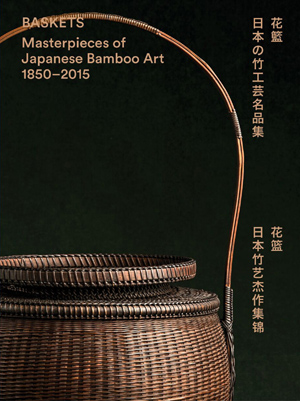BASKETS
Masterpieces of Japanese Bamboo Art
1850–2015
compiled by Joe Earle
with photography by Bertrand Stark


|
Obtainable from any good bookseller or from:
 |
John Adamson:
90 Hertford Street
Cambridge CB4 3AQ, UK
e-mail: Book orders
|
Distributed in the United States and Canada by: |
ACC Art Books, New York
|
Distributed in Japan by:

| MHM Limited
1-1-13-4F Kanda Jimbocho
Chiyoda-ku, Tokyo 101-0051
Japan
+81 (0) 3 3518 9181
e-mail: Book orders
|
|
|
|
Japanese basketry is attracting attention as never before. This ground-breaking catalogue of 323 works by the greatest masters of the
last 150 years combines dramatic photography with a wealth of documentary information, making it both a visual record of a great
collection and an essential reference tool for a developing field of connoisseurship. |
top
It is with great pride and pleasure that the owner of the anonymous ‘Naej Collection’ announces the publication of a trilingual
catalogue featuring three hundred and twenty-three masterpieces of Japanese bamboo art. Although the entire history of the genre
is covered, the Naej Collection is especially strong in works by leading artists from the formative period 1850–1950, when Japanese
basketry was established as an independent medium, the great craft dynasties were founded, and first Osaka and then Tokyo emerged as
major centres of creativity. More than 90 per cent of the baskets are signed and the catalogue breaks new ground by providing full
details and photographs both of the signatures and of the storage-box inscriptions, which include much precious documentary information.
The catalogue is thus not merely the visual record of a great collection but the essential reference work for a developing field of study
and connoisseurship.
The year 2017 was pivotal in the international appreciation of Japanese basketry, old and new. In March of that year, one of Japan’s most outstanding
younger craftsmen succeeded to the title of Tanabe Chikuunsai, becoming the fourth individual to hold that illustrious name (the Naej
Collection includes the largest group outside Japan of works by all four generations of Tanabe Chikuunsai). May 2017 saw the opening of
Japan House São Paulo, the first in an international chain of cultural centers sponsored by the Government of Japan, with “Bamboo: The
Material That Built Japan” as the theme of the opening exhibition, including a selection of masterpieces from the Naej Collection and an
installation by Tanabe Chikuunsai IV. More than 300,000 Brazilians flocked to Japan House during the run of the exhibition.
On June 12, 2017, the Metropolitan Museum of Art inaugurated the exhibition ‘Japanese Bamboo Art: The Abbey Collection,’ widening the audience
for Japanese bamboo art and, in the words of the distinguished Japanese curator Moroyama Masanori, introducing ‘Many more potential
enthusiasts to the expressive power of this ancient and beautiful tradition.’ The Met exhibition closed in early February 2018, having
been seen by 400,000 visitors.
Around seventy works from the Naej Collection formed the major component of the exhibition ‘Fendre l’air—l’art du
bambou japonais [Cleaving the Air: The Art of Japanese Bamboo]’ at the Musée du quai Branly in Paris from 27 November 2018 to 7 April 2019,
the largest exhibition ever held of Japanese bamboo art.
|
top
|
Following an essay outlining the evolution of bamboo art in Japan and a small section introducing earlier Chinese baskets and
Japanese baskets in Chinese style, the bulk of the catalogue is organized by artistic lineages, starting with the founding
father Hayakawa Shokosai I (1815–1897) and his successors and moving on to the other great craft dynasties based in Osaka,
including large sections devoted to the Yamamoto Chikuryosai, Tanabe Chikuunsai, and Maeda Chikubosai lines.
From catalogue number 192 the focus moves to the Iizuka line in Tochigi Prefecture and Tokyo, with numerous works by
Hosai II, Rokansai, and Shokansai.
The story is then continued into the post-war period when artistic basketry came to be practised in many
other parts of Japan and a new generation of masters emerged, supported by patrons in both Japan and the United States.
Each of the fourteen sections of dramatic colour plates (in most cases with both general and detail images) is followed
by a section printed on matt paper with photographs of all the signatures and box inscriptions and biographies of each
artist. The catalogue concludes with a bibliography, glossary, and artist index.
All the information is provided in three languages: English, Japanese, and mainland Chinese using simplified characters.
|
top
|
Joe Earle was Director of Japan Society Gallery in New York until 2012
and has held leadership positions in Asian art departments at the Victoria and Albert Museum, London, and the Museum of Fine Arts,
Boston. Over the past 38 years he has curated, organized, or written catalogues for numerous exhibitions of contemporary Japanese
art, craft, and design, including Japan Style (London, 1980), Japanese Ceramics Today (the Kikuchi Collection, London, 1983),
The Toshiba Gallery of Japanese Art (London, 1986), Visions of Japan (London, 1991), Splendors of Meiji: Treasures of Imperial
Japan (Wilmington, Del. and Portland, Ore., 1999 and 2002), Contemporary Clay: Japanese Ceramics for the New Century (Boston and New
York, 2005 and 2006), New Bamboo (Boston and New York, 2006 and 2008), Serizawa: Master of Japanese Textile Design, (New York, 2009),
Bye Bye Kitty!!!: Between Heaven and Hell in Contemporary Japanese Art (New York, 2011), Fiber Futures: Japan’s Textile Pioneers
(New York, 2011), New Forms, New Voices: Japanese Ceramics from the Gitter-Yelen Collection (New Orleans, 2017). He is now based in London.
|
|
Bertrand Stark was raised in Switzerland. On graduation from Paris University he set out on a career
with an investment bank which sent him straight to Hong Kong. From there his life as a banker took him to the top financial capitals of the
world. When after ten years he was recalled to the bank’s headquarters, he decided to become a photographer. He embarked on his new career by assisting leading
photographers in Germany, the USA and France. After three years’ intensive training, he set up his own freelance practice in fashion.
Now back in Asia, he works in the world of fashion, beauty, and lifestyle photography, contributing to fashion magazines such as Vogue,
Elle, Harper’s Bazaar, Numéro, as well as undertaking advertising assignments for brands like L’Oréal, Nivea, Wella, Opel,
Schwarzkopf and Shanghai Tang. His work has been exhibited at the Pin-Up Studio in Paris and at the Pingyao International Photography Festival
and his photographs feature in a number of books on fashion and beauty. He teaches fashion photography at the Condé Nast Center for
Fashion and Design in Shanghai.
|
top
|
Contact the
publishers or local agents for further information: Enquiries
|
top
|
Please print off the order form and
send it by mail to John Adamson, 90 Hertford Street, Cambridge CB4 3AQ, England.
|
top




